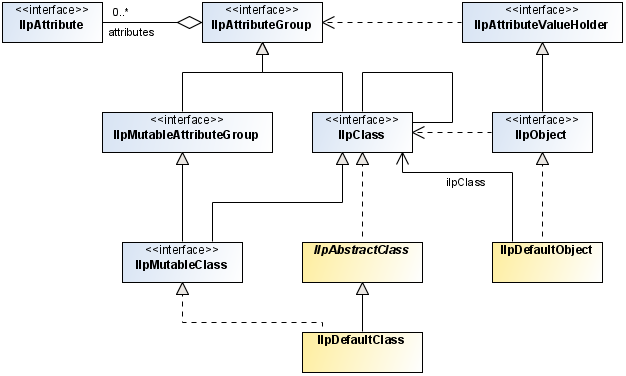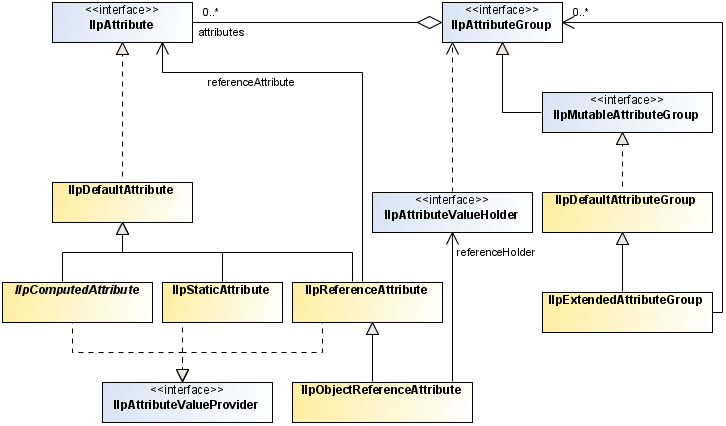Business model API
Describes the API of the components of a business model: business classes, business objects, and attributes.

Provides a diagram of the different classes involved in a business model.

Describes the business class interfaces and their implementations.

Describes the business object interfaces and their implementations.

Describes the attribute-related interfaces and their implementations.
Class overview
The business model API is composed of the following APIs:
The following figure illustrates the various elements that compose the business object model.
The business model API
Business class API
The interface
IlpClass defines static classes. It provides methods to:

Retrieve the class structure, that is, its superclass and subclasses

Retrieve the associated attributes, that is, the attribute group
The interface
IlpMutableClass defines dynamic classes. In addition to the methods listed above, it provides methods to:

Add and remove attributes

Aggregate attribute groups to the class

Notify listeners about these modifications
JViews TGO provides a few convenience implementations of these interfaces that you can use directly or subclass when building an application:
 IlpAbstractClass
IlpAbstractClass—An abstract implementation that helps you create new
IlpMutableClass implementations.
 IlpBeansClass
IlpBeansClass—A wrapper for an existing JavaBean™ class that makes it possible to access it (through introspection) as if it were a dynamic class. Properties discovered during introspection are automatically translated to
IlpBeansAttribute instances and inserted in the class attribute group.
Business object API
The interface
IlpObject defines instances of business classes. These instances (business objects) contain values for the attributes defined by the corresponding class. They also have an attribute group that can be the
IlpClass itself or an extension allowing you to define new attributes at the object level.
Each business object must be assigned to an identifier when it is created. The identifier must be unique (even across data sources); it is used to identify and retrieve the IlpObject. The object identifier can be of any type, as long as it satisfies the following constraints:
1. The identifier must be convertible to
String, through an
IlpTypeConverter installed in the
IlpContext. The
IlpDefaultTypeConverter uses the
Object.toString() method to convert objects of unknown types to
String. The
String that results from this conversion must be unique.
2. It must be possible to create or retrieve the identifier
Object, given the corresponding
String, by using the
IlpTypeConverter installed in the
IlpContext. The
IlpDefaultTypeConverter uses a constructor with a single
String argument to create instances of unknown types.
3. The identifier
Object itself must not be an instance of
IlpObject.
Note the following recommendations:

Ideally the identifier should be implemented as a simple object in order to perform a fast comparison. For the sake of simplicity, it is recommended to use simple objects, such as
Number or
String, which already satisfy the constraints listed above.

If you are using your own Java™ class as identifier, the
public boolean equals(Object obj) method of the identifier class should be overridden to perform an efficient comparison of identifier instances. The
public int hashcode() method should also be overridden and must be consistent with the
public boolean equals(Object obj) implementation.

An identifier generator can be used to generate the object identifiers in a consistent manner. A predefined identifier generator is available in
ilog.cpl.util. IlpIDGenerator.
Note that once the proper implementation for the
IlpTypeConverter is created (normally you do this by subclassing
IlpDefaultTypeConverter), you can register it with the
IlpContext implementation as follows:
IlpContext context = ...;
context.addService(IlpTypeConverter.class, new CustomTypeConverter(context));
For more information about how to customize and extend the behavior of the default type converter, refer to
Type converter and to
Complex types.
The
IlpObject interface has methods to:

Retrieve the object identifier

Retrieve the corresponding business class

Set/get the attribute values, retrieve the attribute group and notify interested listeners, according to the interface
IlpAttributeHolderJViews TGO provides the following convenience implementations of this interface that you can use directly when building your application:
 IlpDefaultObject
IlpDefaultObject—Default object instance created given a class and an identifier.
 IlpBeansObject
IlpBeansObject—Provides a wrapper for an existing JavaBean™ instance, which will allow it to be handled as a dynamic object.
 IlpObjectSupport
IlpObjectSupport—Provides a default implementation for all
IlpObject methods. If your Java classes do not follow the JavaBeans pattern and you cannot create your business objects by inheriting from
IlpDefaultObject, you can write your own implementation of the
IlpObject interface by using the class
IlpObjectSupport.
Attribute API
Attributes are the properties that qualify a business class. For example, an object of type alarm can be qualified by a severity and a description. An attribute is identified by its name and its value and is typed by a Java™ class.
The following figure illustrates the attribute API:
The attribute API
The interface
IlpAttribute defines attributes. It provides the following methods:
 String getName()
String getName() returns the attribute name used as an identifier.
 Object getValueClass()
Object getValueClass() returns the class of the attribute value.
 Object getDefaultValue()
Object getDefaultValue() returns the default value of the given attribute. The default value is used to initialize the attribute in a newly created business object (see
newInstance).
 void setAttributeGroup(IlpAttributeGroup group)
void setAttributeGroup(IlpAttributeGroup group) sets the attribute group that contains the instance.
 boolean isTransient()
boolean isTransient() returns whether the attribute should persist or not when the business object is stored.
JViews TGO provides a set of convenience implementations for
IlpAttribute that you can use directly or subclass in order to obtain application-specific behavior:
 IlpDefaultAttribute
IlpDefaultAttribute—Defines a simple attribute with a name and a value class. The attribute value is not stored in the attribute, but in the object to which this attribute belongs.
 IlpStaticAttribute
IlpStaticAttribute—Defines an attribute with a static value; in other words, this attribute is the same for all objects that contain it.
 IlpReferenceAttribute
IlpReferenceAttribute—Defines an attribute with a value derived from the value of another attribute in the same object instance.
 IlpBeansAttribute
IlpBeansAttribute—Provides a wrapper for an existing JavaBean™ class property; this wrapper makes it possible to access the property (through introspection) as if it were a dynamic attribute.
Attribute group
Attributes are logically gathered in
attribute groups. An attribute group can be static or dynamic. Static attribute groups are defined by the interface
IlpAttributeGroup and dynamic attribute groups are defined by
IlpMutableAttributeGroup.
These interfaces provide methods that allow you to perform the following operations:

Iterate over the list of attributes

Search for a certain attribute given its name

Verify whether a given attribute is present in the attribute group

Insert and remove attributes

Notify interested objects about the modifications described above
JViews TGO provides the following convenience implementations of IlpAttributeGroup :
 IlpExtendedAttributeGroup
IlpExtendedAttributeGroup—Defines a dynamic attribute group that can be extended with other attribute groups. The attribute groups used are not copied, but simply referred to.
Attribute value holder
In
JViews TGO, an attribute value is not carried by the attribute itself but by an
attribute value holder because this value is specific to the object with which the attribute is associated. An attribute value holder is defined by the
IlpAttributeValueHolder interface. Business objects and representation objects carry attribute values, and as such they implement this interface. The
IlpAttributeValueHolder interface includes methods to retrieve and set the value of an attribute, and notify interested objects about changes in attribute values.
Attribute values may be set using the following method:
public void setAttributeValue (IlpAttribute attribute, Object value)
where value may be null.
In cases where attributes have not been set or initialized, the value is IlpAttributeValueHolder.VALUE_NOT_SET.
Attribute values may be retrieved using the following method:
public Object getAttributeValue (IlpAttribute attribute)
Computed attributes
A computed attribute is an attribute which value is derived from the value of one or more other attributes. To implement a computed attribute, you need to extend the abstract class
IlpComputedAttribute and implement its abstract part and a constructor. The abstract part of this class is also known as the
IlpAttributeValueProvider interface.
The
IlpAttributeValueProvider interface contains the following methods:
public Object getValue (IlpAttributeValueHolder h);
public boolean isDependentOn (IlpAttribute a) ;
The
getValue method returns a value that is computed from its attribute value holder parameter. The
isDependentOn method specifies the attributes used to calculate the value of the computed attribute. Whenever the value of one of these attributes changes, the object carrying this attribute notifies its listeners that the computed attribute value has been modified. Note that the computed value is cached. Therefore, calling the
getAttributeValue() method of
IlpAttributeValueHolder twice calls the method
IlpComputedAttribute.
IlpComputedAttribute only once. This cached value is erased whenever the value of an attribute on which the computed attribute depends is modified.
The example below shows how to define a computed attribute that returns a sorted array of integers calculated from another array of integers.
How to define a computed attribute
class SortIntAttribute extends IlpComputedAttribute {
IlpAttribute arrayAttribute;
public SortIntAttribute(String name,
IlpAttributeGroup model,
IlpAttribute arrayAttribute) {
super(name, model, arrayAttribute.getValueClass());
this.arrayAttribute = arrayAttribute;
}
public Object getValue(IlpAttributeValueHolder h) {
Object value = h.getAttributeValue(arrayAttribute);
if (value != IlpAttributeValueHolder.VALUE_NOT_SET) {
int[] array = (int [])h.getAttributeValue(arrayAttribute);
array = (int [])array.clone();
Arrays. sort(array);
return array;
}
return IlpAttributeValueHolder.VALUE_NOT_SET;
}
public boolean isDependentOn (IlpAttribute a) {
return a == arrayAttribute;
}
}
The constructor of SortIntAttributes takes three arguments:
 name
name is the name of the attribute,
 model
model specifies the attribute group (usually, an
IlpClass ),
 arrayAttribute
arrayAttribute specifies the attribute that the computed attribute depends on.
The constructor of the abstract class
IlpComputedAttribute takes three arguments: the name, the model, and the Java class of the value it returns. If the last argument is set to
null, the computed attribute returns
java.lang.Object. In this example, this argument is specified and corresponds to the value class of the attribute on which the computed attribute depends.
The
getValue method computes the attribute value. Computation is protected. As a consequence, if the value of the attribute on which the computed attribute depends is not initialized, or in other words if its value is
IlpAttributeValueHolder, the method does not perform the computation and returns
IlpAttributeValueHolder.VALUE_NOT_SET. In this example, when the value is set, the returned array is duplicated, sorted, and returned.
The implementation of the isDependentOn method is quite straightforward, since in this example the computed attribute depends only on one other attribute, which is specified in the constructor.
Copyright © 2018, Rogue Wave Software, Inc. All Rights Reserved.

